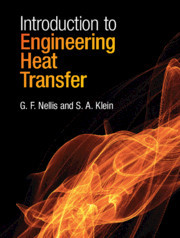Description
Introduction to Engineering Heat Transfer
Authors: Nellis G. F., Klein S. A.
Equips students with the essential knowledge, skills, and confidence to solve real-world heat transfer problems using EES, MATLAB, and FEHT.
Language: English
Subject for Introduction to Engineering Heat Transfer:
Approximative price 81.46 €
In Print (Delivery period: 14 days).
Add to cart
Publication date: 07-2020
895 p. · 19.3x25.1 cm · Hardback
895 p. · 19.3x25.1 cm · Hardback
Description
/li>Contents
/li>Biography
/li>
This new text integrates fundamental theory with modern computational tools such as EES, MATLAB®, and FEHT to equip students with the essential tools for designing and optimizing real-world systems and the skills needed to become effective practicing engineers. Real engineering problems are illustrated and solved in a clear step-by-step manner. Starting from first principles, derivations are tailored to be accessible to undergraduates by separating the formulation and analysis from the solution and exploration steps to encourage a deep and practical understanding. Numerous exercises are provided for homework and self-study and include standard hand calculations as well as more advanced project-focused problems for the practice and application of computational tools. Appendices include reference tables for thermophysical properties and answers to selected homework problems from the book. Complete with an online package of guidance documents on EES, MATLAB®, and FEHT software, sample code, lecture slides, video tutorials, and a test bank and full solutions manual for instructors, this is an ideal text for undergraduate heat transfer courses and a useful guide for practicing engineers.
1. Introduction; 2. One-dimensional, steady state conduction; 3. Extended surface problems; 4. Two-dimensional, steady-state conduction; 5. Lumped transient problems; 6. Transient conduction; 7. Convection; 8. External forced convection; 9. Internal forced convection; 10. Free convection; 11. Boiling and condensation; 12. Heat exchangers; 13. Mass transfer; 14. Radiation; Appendix A. Thermophysical properties of solids; Appendix B. Thermophysical properties of liquids; Appendix C. Thermophysical properties of gases; Appendix D. Thermophysical properties of saturated liquids; Appendix E. Answers to selected problems; Index.
G. F. Nellis is Professor of Mechanical Engineering at the University of Wisconsin, Madison. His teaching expertise has been recognised through awards including the Polygon Engineering Council Outstanding Professor of Mechanical Engineering Award (2013 and 2007), the Pi Tau Sigma Distinguished Professor of Mechanical Engineering Award (2016, 2012, 2009, and 2006), and the J. G. Woodburn award for Excellence in Teaching (2008). He is a Fellow of the American Society of Heating, Refrigeration, and Air-Conditioning Engineers.
S. A. Klein is Emeritus Professor of Mechanical Engineering at the University of Wisconsin, Madison. He is the recipient of the American Society for Mechanical Engineers (ASME) James Harry Potter Gold Medal (2013), the Pi Tau Sigma Distinguished Professor of Mechanical Engineering Award (1991, 1992), and the Polygon Engineering Council Outstanding Professor of Mechanical Engineering Award (1991, 1992). He is a Fellow of ASME, the American Society of Heating, Refrigeration, and Air-Conditioning Engineers (ASHRAE), the American Solar Energy Society (ASES), and the International Building Performance Simulation Association (IBPSA).
S. A. Klein is Emeritus Professor of Mechanical Engineering at the University of Wisconsin, Madison. He is the recipient of the American Society for Mechanical Engineers (ASME) James Harry Potter Gold Medal (2013), the Pi Tau Sigma Distinguished Professor of Mechanical Engineering Award (1991, 1992), and the Polygon Engineering Council Outstanding Professor of Mechanical Engineering Award (1991, 1992). He is a Fellow of ASME, the American Society of Heating, Refrigeration, and Air-Conditioning Engineers (ASHRAE), the American Solar Energy Society (ASES), and the International Building Performance Simulation Association (IBPSA).
© 2024 LAVOISIER S.A.S.




